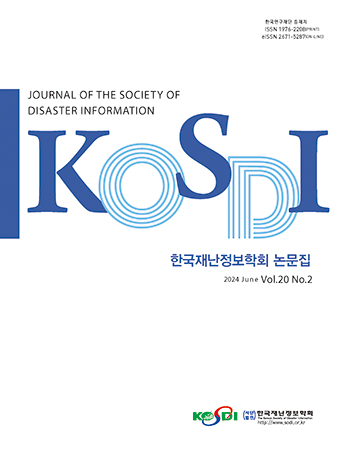Original Article
Abstract
References
Information
Purpose: The purpose of this study is to develop a deep learning-based personal protective equipment detection model for disaster prevention at construction sites, and to apply it to actual construction sites and to analyze the results. Method: In the method of conducting this study, the dataset on the real environment was constructed and the developed personal protective equipment(PPE) detection model was applied. The PPE detection model mainly consists of worker detection and PPE classification model.The worker detection model uses a deep learning-based algorithm to build a dataset obtained from the actual field to learn and detect workers, and the PPE classification model applies the PPE detection algorithm learned from the worker detection area extracted from the work detection model. For verification of the proposed model, experimental results were derived from data obtained from three construction sites. Results: The application of the PPE recognition model to construction site brings up the problems related to mis-recognition and non-recognition. Conclusions: The analysis outcomes were produced to apply the object recognition technology to a construction site, and the need for follow-up research was suggested through representative cases of worker recognition and non-recognition, and mis-recognition of personal protective equipment.
연구목적: 본 연구의 목적은 건설현장의 재해 예방을 위해 딥러닝기반의 개인보호구 검출 모델을 개발하고, 실제 건설현장에 적용하여 분석하는 것이다. 연구방법: 본 연구의 수행 방법은 실제 환경의 데이터를 구축하고, 개발된 개인보호구 검출 모델을 적용하였다. 개인보호구 검출 모델은 크게 근로자 검출 및 개인보호구 착용 분류 모델로 구성되어 있다. 근로자 검출 모델은 딥러닝 기반의 알고리즘을 실제 현장에서 획득한 데이터셋을 구축하여 학습 및 근로자를 검출하였고, 개인보호구 착용 분류 모델은 앞단에서 추출된 근로자 검출영역에서 학습된 개인보호구 검출 알고리즘을 적용하였다. 구축된 모델의 검증을 위해 건설현장 3곳에서 획득된 데이터를 통해 실험결과를 도출하였다. 연구결과: 데이터베이스 12,000장을 구축하여 정상검출 9,460장(78.8%), 오검출 1,468(12.2%), 미검출 1,072장(8.9%)으로 나타났으며 주요 원인은 영상에서의 객체 크기, 객체간 중첩(Occulusion), 객체 잘림, 그림자에 의한 오검출로 분류되었다. 결론: 개인보호구 검출모델은 현장 상황마다 다른 검출률을 확인할 수 있었고, 본 연구의 결과가 차후 현장적용을 위한 연구에 활용될 수 있을 것으로 여겨진다.
- Gil, G. (2017). "Characteristics of Personal Protective Equipment (PPE) in industry accidents." Journal of the Ergonomics Society of Korea, Vol. 36, No. 6, pp. 753-764.
- Hong, M-Y., Park, J-Y., Lee, H-R., Im, C-E., H, J., Son, J-W. (2017). "A study on the development of smart construction safety management framework using big data analysis based on the internet of things." Autumn Annual Conference of AIK, 2017, pp. 1170-1175.
- Im, S, B., Park, C-s., Kim, H., Kim, S., Lee, D-y., Park, K. (2020). "Smart construction technology research program(Part 3) integrated smart safety management technology." Jouran of The Korean Society of Civil Engineers, Vol. 68, No. 8, pp. 45-51.
- Jeong, I., Kim, J., Choi, S., Roh, M., Herbert, B. (2021). "Solitary work detection of heavy equipment using computer vision." Journal of The Korean Society of Civil Engineers, Vol. 41, No. 4, pp. 441-447.
- Kim, D.H., Jo, B.Y. (2021). "A study on the development of a fire site risk prediction model based on initial information using big data analysis." Journal of the Society of Disaster Information, Vol. 17, No. 2, pp. 245-253.
- Kim, H., Kim, G., Shin, J. (2020). "Developing the installation guideline of building monitoring systems for hazardous symptom measurements with visual perception." Journal of the Society of Disaster Information, Vol. 16, No. 2, pp. 374-382.
- Kim, S., Park, J., Kim, G., Kim, S., Na, Y., Song, H., Cho, J., Son, Y., Seok, J., Jo, K. (2021). "A dataset of road environment and bus driving for autonomous car." The 13th International Conference on ICT Convergence, pp. 472-472.
- Lee, O-S., Mun, T-U., Lee, D. (2019). "Safety equipment wearing detection using YOLO based on deep learning." Conference on Information and Control System, pp. 829-830.
- Min, K.S. (2021). "A study on the prevention of safety accidents at construction sites using smart technology." Korean Journal of Safety Culture, Vol. 11, No. 8, pp. 97-114. 10.52902/kjsc.2021.11.97
- Ministry of Employment and Labor (2016-2020). Current State of Occupational Accidents Report 2016-2020.
- Ministry of Employment and Labor (2020). We will Enhance the Safety of Construction Sites by Introducing Smart Safety Equipment." Department of Construction Safety.
- Park, Y-S., Lee, S-Y., Lee, K-T. (2020). "Improving Persnal Protective Equipment Detection In Smart Construction." The Journal of Korean Insitute of Communications and Information Sciences, Vol. 45, No. 12, pp. 2,202-2,209. 10.7840/kics.2020.45.12.2202
- Seo, J.H., Kim, J.D. (2020). "Priority setting for smart construction technologies: adoption by using the house of quality model." Journal of the Korean Production and Operations Management Society, Vol. 32, No. 2, pp. 185-207. 10.32956/kopoms.2020.31.2.185
- Shin, J.K. (2021). Real-time Monitoring System for Personal Protective Equipment of Construction Worker using Smart Technology. Ph.D. Dissertation, Kyonggi University.
- Song, s., Kwak, n. (2021). "Detection of safety helmets using YOLOv5." ICCC 2021, Korea International Conference on Convergence Content, pp. 483-484.
- Publisher :The Korean Society of Disaster Information
- Publisher(Ko) :한국재난정보학회
- Journal Title :Journal of the Society of Disaster Information
- Journal Title(Ko) :한국재난정보학회논문집
- Volume : 18
- No :2
- Pages :269-279
- DOI :https://doi.org/10.15683/kosdi.2022.6.30.269




 Journal of the Society of Disaster Information
Journal of the Society of Disaster Information







